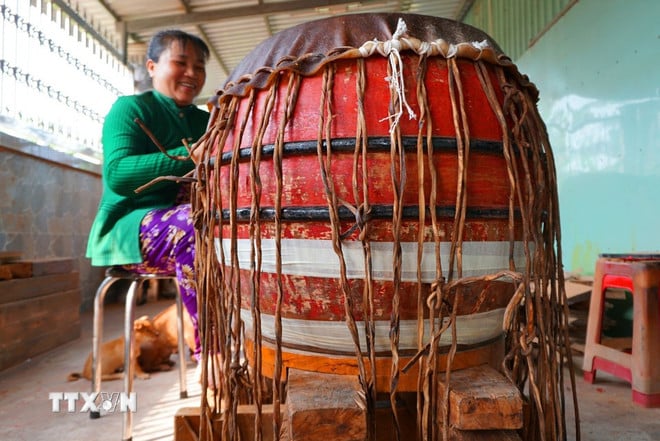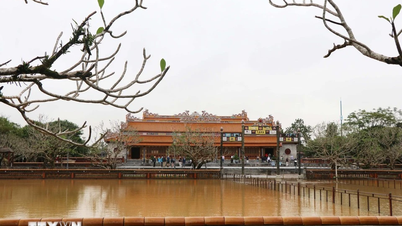Binh An drum craft village in Tan Tru commune, Tay Ninh province - a nearly 200-year-old traditional craft village - has been included in the List of National Intangible Cultural Heritage by the Minister of Culture, Sports and Tourism in Decision No. 2202/QD-BVHTTDL dated June 27, 2025.
When exquisite craftsmanship combines with an understanding of sound and aesthetics
According to the Southern Women's Museum, Binh An used to be An Ninh Ha village, belonging to Cu Ha commune. During the French period, it was called Binh Thanh hamlet. Now Binh An belongs to Tan Tru commune, Tay Ninh province.
Due to favorable natural conditions, fertile forests and plains, people here raised many buffaloes. However, at that time, buffaloes were only raised to pull wood and did not know how to use their skin. Mr. Nguyen Van Ty used buffalo skin to make drum faces and laid the foundation for the development of drum making here.
According to the artisans here, Mr. Nguyen Van Ty was born into a wealthy family but he did not work hard and only gambled, drank a lot, sold all the land his parents gave him, and then had to buy a small boat to do business.
While selling fish sauce along the Vam Co River, he learned the craft of making drums from buffalo skin from an old man on the riverbank.
Using buffalo hides from his hometown, he began making drums to sell. Gradually, his drums became famous throughout the region.
With a long history, Binh An is famous for its sophisticated handmade drum products, diverse in design, size and function.
According to the documents of the Department of Cultural Heritage, Binh An drum making is a combination of sophisticated manual techniques and understanding of sound and aesthetics. The main wooden materials used to make drum bodies are sao or old jackfruit wood, which are durable, light, fragrant and have the ability to create a characteristic resonance. In addition, there are other materials such as cho, tamanu oil (công), rubber...
After being carefully selected, the wood will be cut into panels, dried, and then smoked to prevent termites. The panels are assembled into drum bodies, polished, and shaped into a round shape. The drum heads are then stretched and secured with bamboo or wooden nails - materials that are both durable and do not affect the tone.

To make drums, Binh An is famous for its elaborate techniques. (Photo: Bui Giang/VNA)
The buffalo hide used to make the drum head must be made from the skin of a buffalo over 20 years old, and must be fresh and intact. The final step is to test the sound: the craftsman uses a mallet to tap the drum head to check the resonance, adjusting the tension until the sound is perfect.
Finished products are often painted and decorated with traditional patterns to increase aesthetics and protect the surface.
Drum products of Binh An craft village are very rich and diverse, meeting many different needs in cultural and social life. This place produces many types of drums such as: school drums used to announce school hours; festival drums for ceremonies and processions; temple drums and communal house drums used in religious ceremonies; lion-lion-dragon dance drums for folk art troupes; cheo singing drums and tuong drums for traditional theater; and many types of large and small drums for performing traditional musical instruments or exporting to foreign markets.
Each type of drum has its own manufacturing process and technique, especially in the sound adjustment stage, requiring high level of skill, sophistication and extensive experience of the craftsman. That is what has created the reputation and unique value of Binh An drum products.
The echoes of the drums of Peace
The subject of the heritage is the community of residents of Binh An hamlet - people who have been attached to the drum making profession for many generations. For them, the profession is not only a means of livelihood but also a source of pride, a symbol of family and local tradition.
The value of Binh An drum craft heritage is not only reflected in sophisticated crafting techniques but also spreads across many cultural, social and spiritual aspects.
The drum making profession preserves a treasure trove of valuable folk knowledge, including experience in selecting and processing raw materials, shaping techniques, joining drums, stretching the face, and adjusting the sound.
The profession is passed down through many generations by word of mouth and direct practice - "hands-on." Such knowledge is not only labor skills, but also intangible cultural capital typical of the community, closely linked to local customs, practices and religious life.

The echoes of the Binh An drums have been resounding far and wide. (Photo: Bui Giang/VNA)
The crafting process also connects generations, as everyone participates from the raw material preparation stage to the finished product. Each stage requires coordination, sharing and mutual support, contributing to fostering solidarity, community awareness and pride in the unique identity of Binh An hamlet.
Through the apprenticeship process, the young generation not only acquires crafting skills but also cultivates perseverance, meticulousness, creativity and a sense of responsibility. Participating in the profession helps them understand and love tradition, appreciate the efforts of their ancestors and nurture the awareness of preserving heritage.
For tourists, experiencing the drum-making process firsthand is an opportunity to discover a vivid slice of national culture, thereby spreading love and appreciation for Vietnam's cultural heritage.
Drum production not only creates livelihoods for local people but also maintains a network of cultural and commodity exchanges between Binh An and other regions, promoting local socio-economic development.
Binh An drum craft village not only makes musical instruments for cultural and religious activities but is also a symbol of the ingenuity, creativity and perseverance of the people here.
The echoes of Binh An drums have been resounding far and wide, contributing to enriching the spiritual life of the community, while affirming the significance of preserving and promoting a unique cultural heritage of the nation./.
(Vietnam+)
Source: https://www.vietnamplus.vn/giu-nhip-hon-dan-toc-qua-di-san-nghe-trong-binh-an-o-tay-ninh-post1074782.vnp


![[Photo] Opening of the 14th Conference of the 13th Party Central Committee](https://vphoto.vietnam.vn/thumb/1200x675/vietnam/resource/IMAGE/2025/11/05/1762310995216_a5-bnd-5742-5255-jpg.webp)




































![[Photo] Panorama of the Patriotic Emulation Congress of Nhan Dan Newspaper for the period 2025-2030](https://vphoto.vietnam.vn/thumb/1200x675/vietnam/resource/IMAGE/2025/11/04/1762252775462_ndo_br_dhthiduayeuncbaond-6125-jpg.webp)










































































Comment (0)